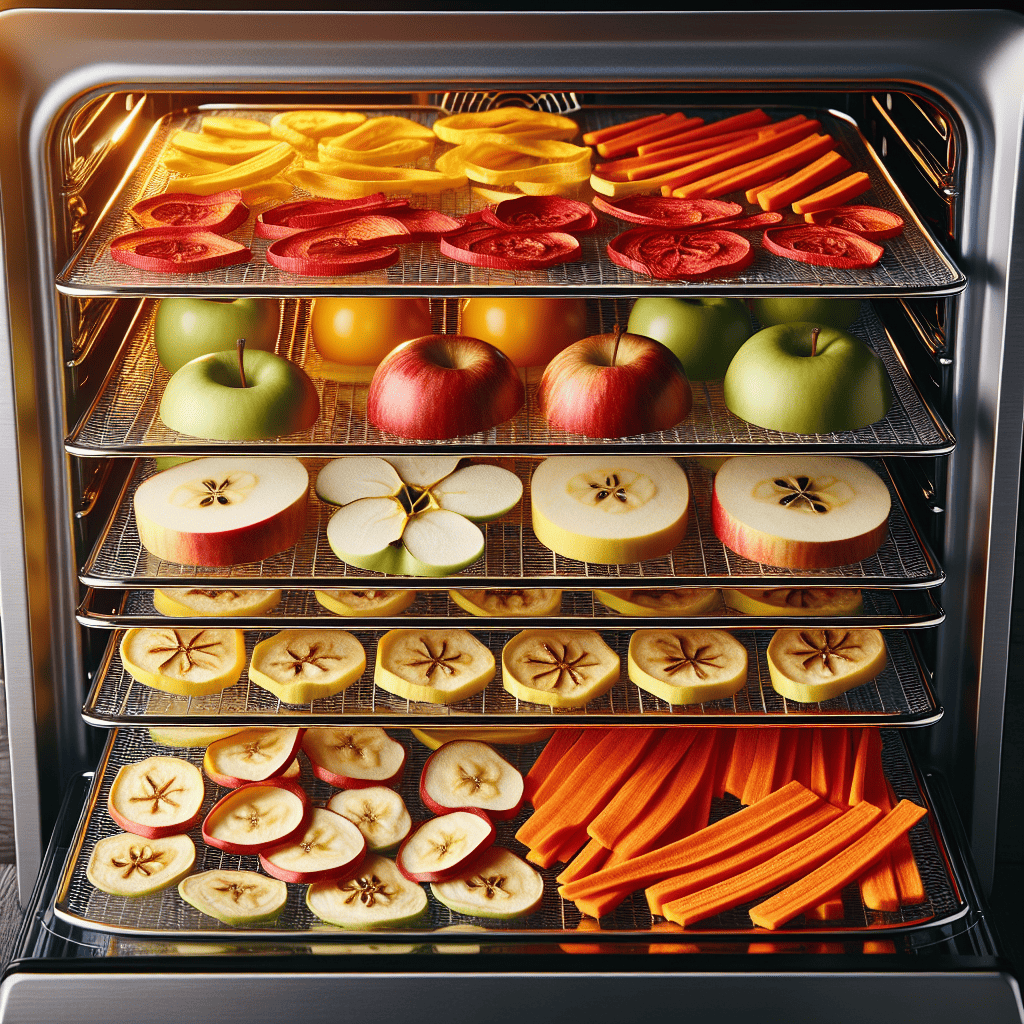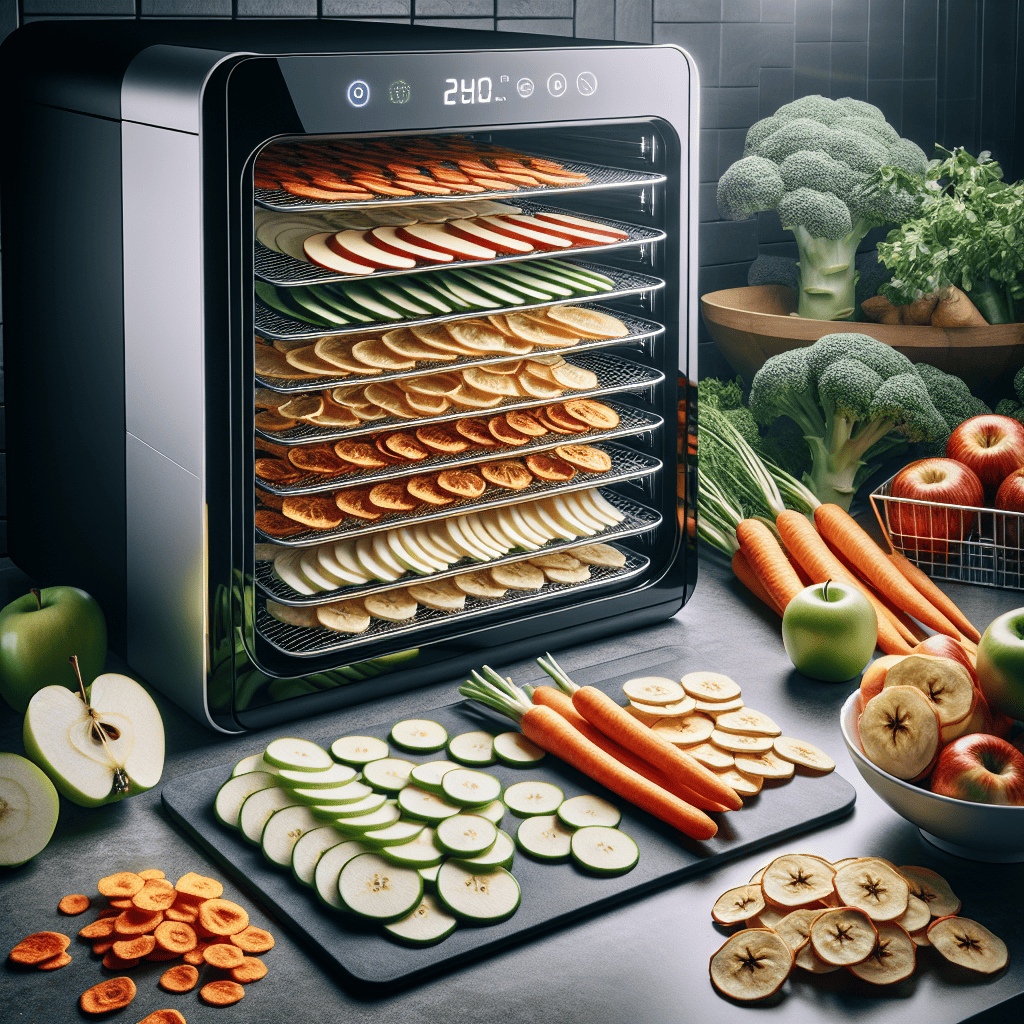Imagine transforming your favorite fruits and veggies into perfect, pliable chips with just your smart oven. Intriguing, isn’t it? Well, your kitchen companion is more versatile than you might think. The art of food dehydration isn’t just for those with a dedicated dehydrator. Your hi-tech appliance can play the part too, making brands like Breville and KitchenAid not just your baking buddies but also your snack-making sidekicks. By embracing this method, you’re on your way to creating preservative-free, nutrient-rich munchies that not only satisfy your snack cravings but also contribute to your well-being. So, clear out your oven racks and prep your produce, because you’re about to make healthful snacking a whole lot easier.
Understanding Food Dehydration
The basics of food dehydration
So, you’re curious about food dehydration? Let’s dive into it. Food dehydration is essentially the process of removing moisture from food by circulating hot air around it. Why remove the moisture? Well, because bacteria, yeast, and mold love water, and by getting rid of it, you’re inhibiting their growth – which means your food lasts longer. It’s a preservation method that’s been around for ages, from sun-drying tomatoes in Italy to air-drying jerky in the Americas.
Benefits of dehydrating food
Now, why should you dehydrate food? For starters, it’s a fantastic way to reduce food waste. Got some ripe bananas or berries on the verge of going bad? Dehydrate them for later! It’s also super convenient – dehydrated foods are lightweight and perfect for on-the-go snacks or for camping trips where you don’t want to lug around a cooler. Plus, dehydrating your food can help you save money, especially if you buy in bulk and preserve for later.
Nutritional advantages of dehydrated snacks
But that’s not all – dehydrated snacks have a nutritional edge, too. By gently removing the moisture without cooking at high temperatures, you’re retaining more vitamins and minerals compared to other preservation methods. And without all the added sugars and preservatives found in some store-bought snacks, your homemade dehydrated fruits and veggies are healthier. Plus, they keep their intense, natural flavor, making them a delicious treat.
Selecting the Right Smart Oven
Key features to look for in a smart oven
Now, let’s talk ovens. Not just any oven – a smart oven. When scouting for one, consider these must-have features: consistent temperature control, a dehydrate function (of course), and programmable settings that allow you to customize and save your recipes. Look for one with convection capabilities too, as it’ll circulate hot air more effectively – key for even drying.
Popular smart oven brands for dehydrating
A few smart oven brands that stand out for dehydrating are the Breville Smart Oven Air, known for its precision and versatility, and the June Oven, which offers a ton of preset functions, including dehydrating. The Cuisinart Convection Toaster Oven Airfryer is another top pick, as it’s a multi-tasker that includes a dehydrating setting.
Comparing price vs performance in smart ovens
When it comes to smart ovens, price can indicate quality, but that’s not always the case. Sometimes, you might just be paying for a brand name. What’s important is performance – does it maintain a consistent low temperature needed for dehydrating? Is the air circulation efficient? A mid-range oven often does just as good a job as a high-end model, so balance your budget with the features you truly need.

Preparing Foods for Dehydration
Choosing the best foods for dehydration
Selecting the right foods for dehydration is critical. Almost any fruit or vegetable can be dehydrated, but some standouts include apples, bananas, cherries, and kale. They retain a great texture and flavor post-dehydration. Look for fresh, ripe, high-quality produce without bruises or spots, as the better the produce, the tastier the end product.
Washing and prepping fruits and vegetables
Before dehydrating, give your fruits and veggies a good wash under cold water to remove any dirt or pesticides. And, even though it’s time-consuming, pat them dry – you want as little moisture as possible before they hit the oven. This ensures even dehydration and reduces the chance of spoilage.
Slicing techniques for even drying
Equal slicing is your friend when it comes to dehydrating. Uniform slices mean everything dries at the same rate, preventing some pieces from being overdone while others are still moist. A mandoline slicer is a nifty tool to get even, consistent cuts. And remember, the thinner the slice, the quicker it will dehydrate.
Smart Oven Dehydration Settings
Understanding your smart oven’s dehydrating capabilities
Before you start, get to know what your smart oven can do. Does it have a temperature range low enough for delicate herbs as well as one high enough for meaty jerky? Check the manual to understand the specific dehydration settings – this will help you achieve the best results.
Adjusting temperature and time for different foods
Each food has its own ideal dehydrating temperature and time. For instance, herbs may dry out nicely at 95°F, while beef jerky might need a setting around 155°F. Timing varies greatly too – some snacks are done in a couple of hours, while others might need a full day. Patience is vital here; keep an eye on the clock and don’t rush the process.
Utilizing pre-programmed dehydration settings
Thankfully, many smart ovens come with pre-programmed settings, taking out the guesswork. If yours has these, use them! They’re typically calibrated for the best balance of time and temperature and can make your dehydration journey much smoother.

Tips for Efficient Dehydration in Your Smart Oven
Tray arrangement for optimal airflow
Inside your smart oven, it’s all about airflow. Arrange trays so there’s plenty of space for air to circulate around each slice of food. Overcrowding can lead to uneven drying. If your oven has multiple racks, use them and rotate the trays periodically during dehydration to promote uniform drying.
Monitoring dehydration progress
Don’t be shy about peeking in on your snacks. Monitoring is crucial, especially towards the end of the drying cycle, to make sure nothing gets overdone. Touch the food – if it feels dry but still pliable, it’s often good to go. Remember, foods will harden up a bit more once they cool.
How to prevent over-drying
No one likes a snack that’s too chewy or crisp beyond recognition. To prevent over-drying, start checking the food towards the end of the recommended drying time. Once you get the hang of how your oven works, you’ll get better at judging the perfect doneness.
Creating a Variety of Dehydrated Snacks
Recipes for fruit leathers
Fruit leathers are a hit with all ages and super easy to make. Puree ripe fruits, spread the mixture thinly on a silicone baking mat, and dehydrate until it’s no longer sticky. The beauty is you can mix different fruits and even add some spices – think cinnamon or vanilla – for extra pizzazz.
Making crunchy vegetable chips
Craving something crunchy? Vegetable chips are a nutritious alternative to the store-bought kind. Thinly slice your veggies – beets, sweet potatoes, and zucchini work well – season, and dehydrate. They’re addictive, and you can play around with seasonings like paprika or rosemary to keep your taste buds entertained.
Preparing jerkies and dehydrated meats
Meat lovers, you’re not left out. Jerky is the dehydrated meat snack you can easily customize. Choose a lean cut, slice it thinly against the grain, marinate it to your liking, and dehydrate. The result is a protein-packed, savory snack perfect for refueling during the day.
Storing Dehydrated Foods
Best practices for storing dehydrated snacks
Once your snacks are cool and dry, store them properly to maintain freshness. Airtight containers or vacuum-sealed bags are perfect for this. Keep them in a cool, dark place to prolong their shelf-life, and if you’ve made a large batch, consider dividing it into smaller portions to keep unopened ones fresher for longer.
Maximizing the shelf life of your snacks
Moisture is the enemy of shelf life. To maximize it, ensure your snacks are fully dehydrated before storing. If in doubt, it’s better to overdry than underdry. Adding a desiccant pack to the storage container can help absorb any rogue moisture and keep your snacks crisp.
Packaging ideas for on-the-go consumption
For those times you need a quick nibble while out and about, think about portable packaging. Small resealable bags or compact tins can fit into your bag or glove compartment, making it easy to snack healthily on the move. Plus, they’re less likely to get crushed compared to carrying around loose pieces.
Safety Considerations While Dehydrating
Importance of proper food handling
Proper food handling is a must. Always start with clean hands, utensils, and surfaces to reduce the risk of contamination. This is especially critical when preparing meats, where the risk of bacterial growth is higher.
Signs of improperly dehydrated food
Keep an eagle eye out for signs of improperly dehydrated food – mold, a rancid smell, or unexpected softness may indicate the food hasn’t been dehydrated correctly or has absorbed moisture. If in doubt, it’s better to discard the food than risk food poisoning.
Avoiding contamination during the dehydration process
Contamination can happen post-dehydration too. So when you’re checking or rotating your snacks, use clean utensils or gloves. And once the dehydration is finished, let everything cool down in an area free from contaminants before you pack them up.
Enhancing the Flavor of Dehydrated Snacks
Using spices and seasonings
A little seasoning goes a long way. Sprinkle spices or herbs on your fruits and veggies before they go into the oven to give them a flavor boost. From cinnamon-spiced apples to chili-lime mangoes, the combinations are nearly endless.
Marinating techniques before dehydration
For an extra flavor punch, especially with meats, marinating is your best bet. Submerge your slices in a savory mixture a few hours before dehydrating. The longer they marinate, the more intense the flavor will be. Just remember to pat them dry before they go into the oven.
Combining different foods for flavor variety
Why not mix and match? Combining different foods can result in unique flavor profiles. Try dehydrating mixed fruits for a tropical medley or pair different vegetable slices with complementary seasonings. It’s like creating your personal snack mix.
Expanding Your Dehydrating Horizons
Trying exotic fruits and veggies
Don’t be afraid to experiment with exotic fruits and veggies. Have you ever tried dehydrated star fruit or dragon fruit? The dehydrating process can make even the most unusual foods more palatable and interesting.
Making dehydrated meals for camping and hiking
If you’re into outdoor adventures, dehydrated meals are a godsend. You can dehydrate your own ingredients – like cooked beans, rice, or seasoned ground beef – and then simply rehydrate them on the trail for a satisfying meal. Just add hot water!
Incorporating dehydrated foods into daily diets
Finally, think beyond snacks. Dehydrated foods can be a staple in your daily diet. Mix dried fruits into oatmeal, create your crunchy granola, or give your soups a thicker texture with dried vegetables. Dehydrating can open up a whole new world of culinary possibilities – so go ahead and explore!

